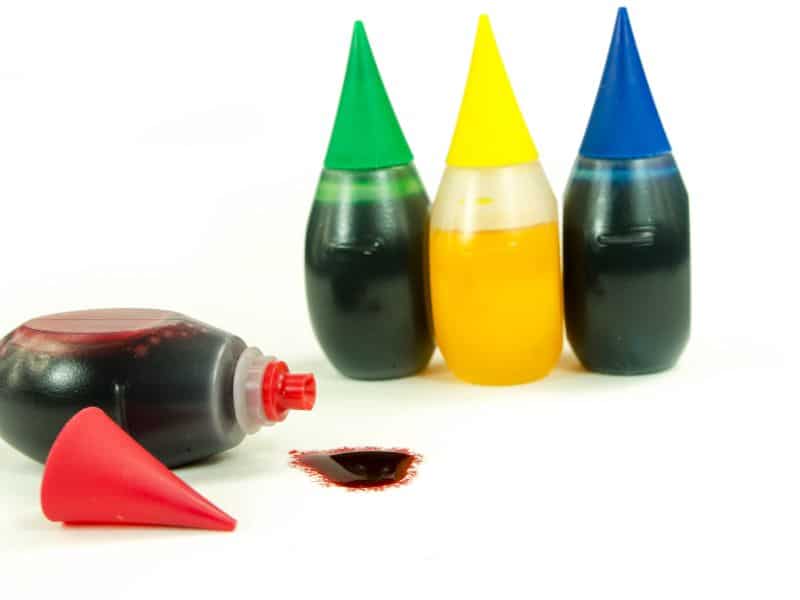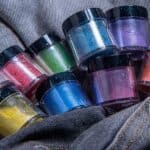Melt-and-pour soap is an easy, fun way to make homemade soaps with endless possibilities for creativity. These soaps come pre-made, usually in solid blocks that you can easily melt down and add your desired mix-ins. One of these mix-ins is dye! You can customize the color of your soap bars to create artistic patterns. So what kind of dye should you use for melt-and-pour soap making? Can you use food coloring in melt and pour soap? Read on to find out more.
Using food coloring in melt-and-pour soap is not recommended. Food coloring does not maintain its appearance well, it will fade, and when using multiple colors it will run together and become discolored looking unprofessional.
So while you may not want to use food coloring in your next batch of soap the good news is that you have some other options available to color your melt and pour soap. You have natural options such as mica and lab-made colorants specifically designed for soap making. Let’s take a look.
Best Dye For Melt And Pour Soap
When dying melt and pour soap you can use any liquid water-based dye as well as micas, clays, and a variety of natural colorants. You can choose any liquid dye, however, the key is to not use food coloring as it will discolor and fade over time.
Liquid Dye
Liquid soap dye is a pigment that will create a marbling effect in the melt-and-pour soap. This type of dye is food grade and is made specifically for soap making. It behaves differently than food coloring and will not fade or run together.
When using liquid dye try using FD&C dyes, as they are food grade and made for cosmetics. Just make sure to only use a few drops at a time as too much will result in a gray, murky color.
Mica Powders
Mica powders are another great option for melt-and-pour soap making. Mica powder is a natural mineral mined from the earth and then processed into a fine powder to be used in cosmetics. These highly pigmented powders create a beautiful shimmery effect and can be used to create vibrant colors for your soap.
To use mica powder in melt and pour soap, start by taking a teaspoon of the powder and adding it to a plastic container. Slowly add 1/4 teaspoon of vegetable glycerin or liquid oil to the powder and mix until you form a paste. Take this paste and add it to your melted soap base, stirring until completely blended.
Natural Colorants
If you want to go 100% natural and avoid synthetic dyes, there are some options available for you. Plant-based ingredients such as spirulina and alkanet root can be used to color your soap. You can also use clay, oxides, and natural colorant extracts.
Clays are great for adding color and texture to your soap. To use clay in melt and pour soap, start by taking a teaspoon of clay and blending it with 1/4 teaspoon of vegetable glycerin or liquid oil until you form a paste. Add this paste to your melted soap base and stir until completely blended.
This is a great way to color your melt-and-pour soap without having to use food coloring.
How Do You Dye Melt And Pour Soap
To dye your melt and pour soap, you will first need to melt the base. Once melted, add your desired colorant. Start with just a few drops at a time until you reach the desired color. You can always drizzle a little bit of soap on a sheet of paper and let it cool just to get an idea of how the color is going to change once the soap hardens. Make sure to mix well to ensure that the dye is evenly distributed evenly throughout the soap.
Depending on the results of your color test on a sheet of paper you can always add more if needed. Once you are happy with the color, pour it into molds and let the soap fully cool for about 4-6 hours. And voila, you have colored your own melt-and-pour soap!
Things Not To Dye Soap With
This may go without saying but I am going to say it just in case. We want to everyone that’s going to be making soap that people will put on their skin to be 100% clear.
Things Not To Add To Soap:
- Food Coloring
- Crayons
- Paint
- Non-cosmetic dyes
These are not food-grade or cosmetic safe and can be irritating to the skin, so avoid using them altogether.
Soap Dye Safety Tips
Here are some safety tips to help you when it comes to dying your melt-and-pour soap.
- Always use cosmetic-grade dye
- Start with just a few drops
- Mix well
- Use hypoallergenic ingredients
- Use proper safety equipment
While making and dying soap may not be inherently dangerous it is still a good idea to follow these tips because they can help prevent any issues that may arise. In addition, using proper safety equipment can keep you from dying your skin or getting something in your eyes.
Frequently Asked Questions
Yes, you can purchase food-grade dyes specifically made for coloring melt and pour soap.
Yes, most soap dyes will expire over time. To be sure that the dye you are using is still effective it’s a good idea to check the expiration date on the packaging before using it.
Soap dye can be stored in a cool, dark place away from heat and direct sunlight. Make sure that the lid is sealed tightly to avoid moisture getting in.
No, food coloring is not food grade and will discolor and fade over time. We recommend using FD&C dyes, mica powders, clays, or natural colorants to achieve the desired results.
Start by melting the base. Once melted, add your desired colorant. Begin with just a few drops at a time until you reach the desired color. Make sure to mix well to ensure that the dye is evenly distributed throughout the soap. Then, pour it into molds and let the soap fully cool for about 4-6 hours.
Make sure to always use cosmetic grade dye, start with just a few drops, mix well, and use hypoallergenic ingredients. Additionally, be sure to wear proper safety equipment when working with dyes.
Conclusion
Using food coloring in melt-and-pour soap is not recommended as it can lead to discoloration and fading over time. Fortunately, there are a variety of other options available such as FD&C dyes, mica powders, clays, or natural colorants that can be used to achieve the desired results.
As always, make sure to follow safety tips when handling dye and store your dye securely in a cool, dark place away from heat and direct sunlight. With a little knowledge and patience, you too can be well on your way to creating beautiful colored melt-and-pour soap!






